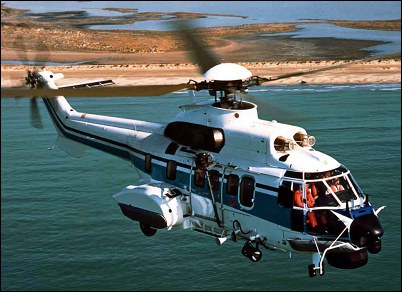
| Aerospatiale AS.332 "Super Puma" 1945 |  |
 |

| Aerospatiale AS.332 "Super Puma" 1945 |  |
 |
|
A cabin big enough to accommodate 24 passengers on standard seats is clearly big enough to earn- smaller numbers in much greater comfort. Aerospatiale has exploited the possibility in a big way, and claims to have created the market for VIP helicopters by combining the versatility of rotary-wing flight with the all the comforts of a business jet. The Prestige range of VIP interiors offers luxuriously upholstered seating in a single nine-seat cabin, or separate compartments with four seats forward and another eight aft, along with such amenities as a bar, individual video screens and telephones. Super Pumas and Cougars are used to transport no fewer than 25 heads of state, and more than 50 VIP versions are in service. Apart from the 8m long cabin, the type's attractions include low noise and vibration levels and large windows along with high performance and long range. Other roles have included supporting the United Nations peace-keeping force in Mozambique. The Super Puma is well suited to operations in Africa, where it is able to take off with full tanks even in temperatures of 30°C. R.Jackson "Helicopters. Military, Civilian, and Rescue Rotorcraft", 2005
The design of this derivative of the SA.330 Puma commenced in 1974 and the definitive prototype was preceded by a modified Puma, the AS.331, which flew in September 1977 with an uprated transmission driven by two Turbomeca Makila turboshafts. The first AS.332 flew on 13 September 1978 and introduced a number of further changes to improve payload, performance and survivability, and to reduce maintenance. These changes included a new energy-absorbing landing gear with increased wheel base and track, a lengthened nose section, more efficient fiberglass main and tail rotors, greater fuel capacity, and revised fin and tail plane contours to improve handling. Subsequently in 1980 a fourth prototype introduced a cabin stretch of 0.76m with two additional windows and accommodation for up to three more passengers. There are currently five main versions of the Super Puma, based on short and long fuselage variants. The AS.332B is the standard military version, which to date has been supplied to Abu Dhabi, Argentina, Chile and Spain, whilst the AS.332F is a naval variant armed with two Exocet missiles for antishipping duties. The civil equivalent of these two short fuselage variants is the AS.332C. The two stretched variants are the AS.332M military transport and the AS.332L civil version. The latter has become popular with offshore support operators, particularly in the North Sea where six major operators had the type in service at the beginning of 1984. This included 34 aircraft with Bristow Helicopters, redesignated Tigers to signify equipment differences from the standard AS.332L. Orders for 150 Super Pumas had been received by late 1983, including license-built aircraft being assembled by Nurtanio of Indonesia. G.Apostolo "The Illustrated Encyclopedia of Helicopters", 1984
- The first flight of the AS 332 Super Puma was on 13 September 1978. Service entry occurred in 1981. - Civilian Super Pumas have the capacity to seat 24 passengers. - Luxury variants have been developed to fill the VIP transport role. - In the event of a mishap, the Super Puma is able to land on water because of the fitting of emergency flotation bags. - One variant, the AS 332L, has more than 70 examples in civilian service. - Super Pumas are widely used as transports for oil exploration support. - Petroleum Helicopters, the world's largest user of helicopters, uses Pumas and Super Pumas. - About 420 Super Puma/Cougar helicopters have been built, about half of them used by civil operators. - The military Puma variant, the AS 532 Cougar, is used by 32 countries. - The Super Puma Mk II introduced new main and tail rotors and transmission.
|